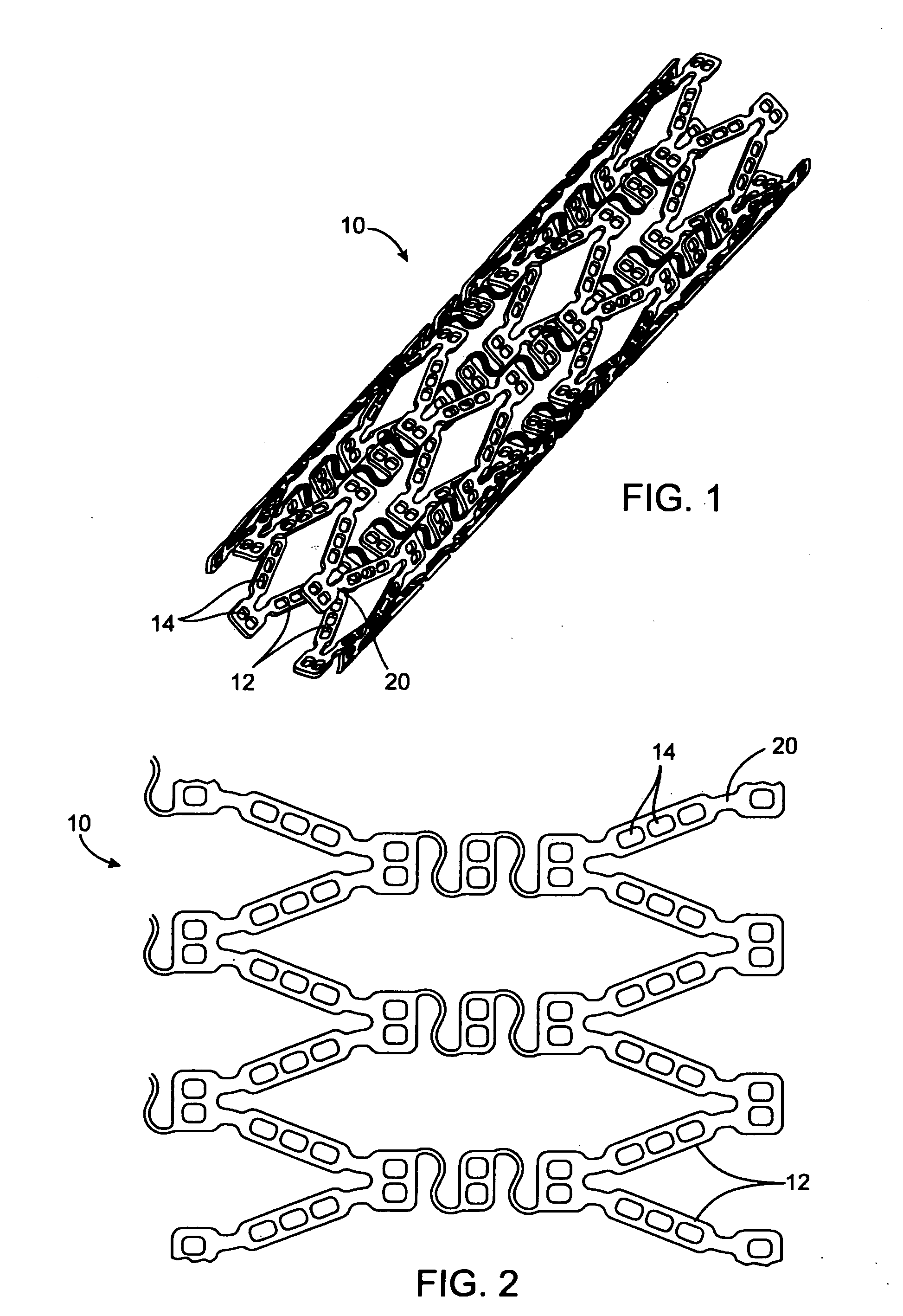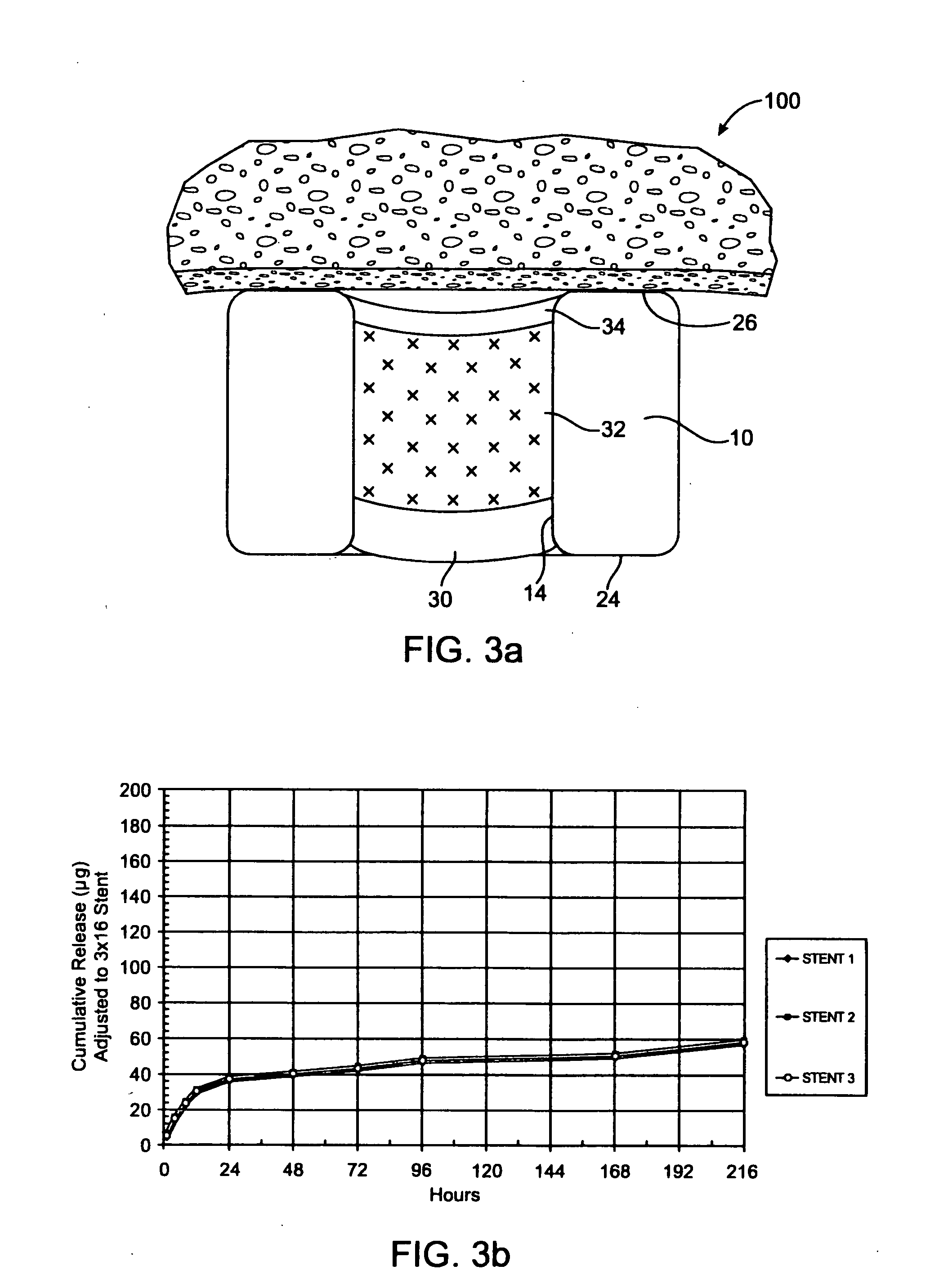Methods and systems for delivering immunosuppressant and anti-inflammatory agents from a stent
a technology of which is applied in the field of methods and systems for delivering immunosuppressant and anti-inflammatory agents from a stent, can solve the problems of post-angioplasty vessel closure, major complications, and increased trauma and risk to patients, so as to and reduce the risk of infection
- Summary
- Abstract
- Description
- Claims
- Application Information
AI Technical Summary
Benefits of technology
Problems solved by technology
Method used
Image
Examples
example 1
[0045] In one example, the stent of FIG. 3a includes a barrier region 30 of PLGA, a therapeutic agent region 32 of PLGA and Pimecrolimus at a drug / polymer ratio of 1 / 1, and a cap region 34 of PLGA. Each reservoir is filled, by volume, with about 25% barrier, 60% drug / polymer, and 5% cap. The total Pimecrolimus loaded on the stent is about 175 μg on a 3 mm×16 mm stent. The resulting in vitro release is given in FIG. 3b. In this example, the entire release is expected to be completed within about 30 days based on the selection of the polymer.
[0046]FIG. 3b shows that after 24 hours, the release profile is substantially linear.
[0047] The measurement of in vitro Pimecrolimus release from a stent can be performed according to the following procedure. The in vitro release from other implantable medical devices can be performed in a similar manner by measurement of total drug load and release kinetics by high pressure liquid chromatography (HPLC).
[0048] The release kinetics time points a...
example 2
[0056] In another example, the stent of FIG. 4a includes a base region 40 of PLGA, and a therapeutic agent region 42 of PLGA and Pimecrolimus at a drug / polymer ratio of 3 / 1, and no cap region. Each reservoir is filled, by volume, with about 25% base and about 75% drug / polymer. The total Pimecrolimus loaded on the stent is about 300 μg. The resulting in vitro release is given in FIG. 4b. FIG. 4b shows that release is substantially linear after the first 24 hours. About 25 to 50 percent of the drug on the stent is released in the first 24 hours. The entire release is expected to be completed within about 30 days based on the selection of the polymer.
example 3
[0057] In another example, the stent of FIG. 5a includes a base region 50 of PLGA, and a first therapeutic agent region 52 of PLGA and Pimecrolimus at a drug / polymer ratio of 3 / 1, a second therapeutic agent region 54 of PLGA and Pimecrolimus at a drug / polymer ratio of 19 / 1, and no cap region. The total Pimecrolimus loaded on the stent is about 315 μg. Each reservoir is filled, by volume, with about 25% base, 50% first drug / polymer region, and 25% second drug / polymer region. The resulting in vitro release is given in FIG. 5b. FIG. 5b shows that the release is substantially linear after the first 24 hours. About 10 to 25 percent of the drug is released in the first 24 hours. The entire release is expected to be completed within about 60 days based on the selection of the polymer.
PUM
| Property | Measurement | Unit |
|---|---|---|
| Fraction | aaaaa | aaaaa |
| Fraction | aaaaa | aaaaa |
| Fraction | aaaaa | aaaaa |
Abstract
Description
Claims
Application Information
 Login to View More
Login to View More - R&D
- Intellectual Property
- Life Sciences
- Materials
- Tech Scout
- Unparalleled Data Quality
- Higher Quality Content
- 60% Fewer Hallucinations
Browse by: Latest US Patents, China's latest patents, Technical Efficacy Thesaurus, Application Domain, Technology Topic, Popular Technical Reports.
© 2025 PatSnap. All rights reserved.Legal|Privacy policy|Modern Slavery Act Transparency Statement|Sitemap|About US| Contact US: help@patsnap.com



